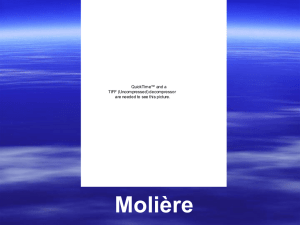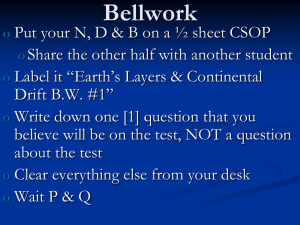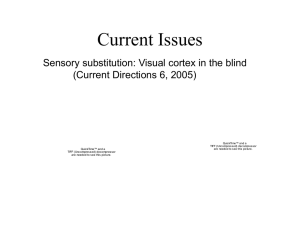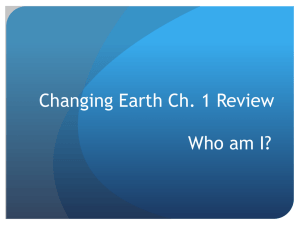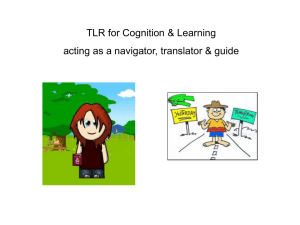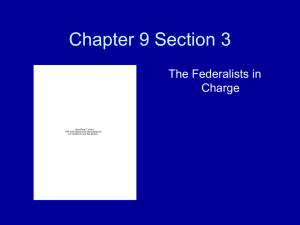Lesson 1 Notes
advertisement
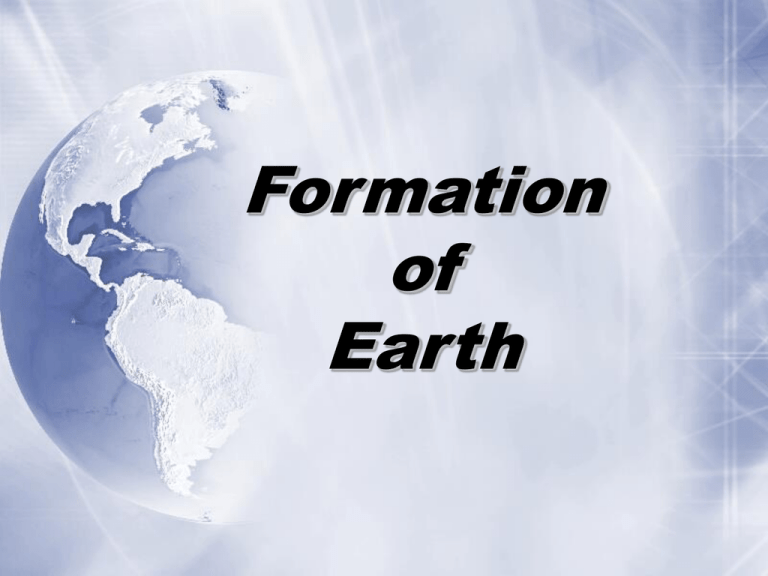
Formation of Earth About 300 million years ago, Earth looked differently … QuickTime™ and a TIFF (Uncompressed) decompressor are needed to see this picture. Moving land masses came together to form the super continent of Pangaea QuickTime™ and a TIFF (Uncompressed) decompressor are needed to see this picture. If they were once together, why are they now apart, and what forces could move such large land masses? In 1915, Alfred Wegener, a German scientist, said that the only possible answer was continental drift. He suggested that 300 million years ago all of the earth’s land masses, which were in constant motion, collided to form one supercontinent. He called it Pangaea (“all land”). Wegener’s Theory QuickTime™ and a TIFF (Uncompressed) decompressor are needed to see this picture. Wegener believed that the land masses broke into pieces due to the weaknesses in the earth's crust. They were made up of less dense materials and caused them to drift centimeter by centimeter over millions of years until they arrived at where they are now. Figure 1.5 shows how the Pangaea split up into plates and drifted over the millions of years. QuickTime™ and a TIFF (Uncompressed) decompressor are needed to see this picture. This figure shows how the Pangaea split up into plates and drifted over the millions of years. What Kind of Evidence Supported Continental Drift? He saw the jigsaw fit between South America and Africa What Kind of Evidence Supported Continental Drift? He found fossils of the same plants and animals on both continents. He felt that they could only exist in both places if the continents were once joined together. What Kind of Evidence Supported Continental Drift? Wegener tried to prove that there were mountains that were similar in age and structure on both sides of the Atlantic Ocean - the Appalachians in the eastern United States and Canada, and similar mountains in the northern British Isles and Europe. These mountains formed about 300 million years ago when North America collided with Europe and Northern Africa What Kind of Evidence Supported Continental Drift? • Ice sheets covered southern Africa, India, Australia, and South America about 250 million years ago. • Matching glacial deposits were found • How could this ice develop in places that are so warm today? The only explanation seemed to be that at one time the continents were located closer to the South Pole. What Kind of Evidence Supported Continental Drift? Past climates EVIDENCE THAT SUPPORTED CONTINENTAL DRIFT THEORY 1. Jig-saw puzzle fit of continents 2. Matching rocks and mountain belts 3. Similar fossils on different continents 4. Evidence of similar past climates 5. Matching glacial deposits Wegener’s Theory? • Most scientists disagreed with Wegener • he could not explain how the continents moved • Canadian J. Tuzo Wilson helped spark new interest in theory. • By 1968, a new theory, known as plate tectonics, was developed Plate Tectonics What does tectonic mean? It relates to the internal force which deforms the earth’s crust The Earth QuickTime™ and a TIFF (Uncompressed) decompressor are needed to see this picture. • Our planet might seem fixed and rigid, but a closer look reveals that it is constantly shifting under our feet. Earth's Structure What's inside the earth? • the early part of the 20th century, geologists studied the vibrations (seismic waves) generated by earthquakes to learn more about the structure of the earth's interior. They discovered that it is made up of these distinct layers: the crust, the mantle, and the core. QuickTime™ and a TIFF (Uncompressed) decompressor are needed to see this picture. Crust - hard and rigid, it’s the earth’s outermost and thinnest layer, only a few miles (5 km) thick under the oceans and averaging 20 miles (30 km) thick under the continents Mantle - subdivided into 2 regions, upper and lower, this dense layer made of hot, semisolid rock is located directly below the crust and is about 1800 miles (2,900 km) thick Inner Core - an extremely hot, solid sphere of mostly iron and nickel at the center of the earth. It is 3,200 to 3960 miles (1200 km) in diameter Outer Core - the outer core is the only liquid layer of the earth - a sea of mostly iron and nickel. It is roughly 1800 to 3200 miles 92890 to 5150 km) below the surface and about 1400 miles (2300 km) thick • Plate tectonics is the theory that helps explain most geologic processes • It states that the earth’s outer shell is made up of about twenty plates QuickTime™ and a TIFF (Uncompressed) decompressor are needed to see this picture. • Most of these plates are made up of both a continent and an ocean. • They are moving over a weak layer of hot rock, several hundred kilometres below the earth’s surface, which flows like slowmoving plastic • Unequal distribution of heat within the earth causes convection currents to move the plates Plate Movement • “Plates” of lithosphere are moved around by the underlying hot mantle convection cells How Do The Plates Move? • There are three ways: Convergent: the plates move toward each other and collide Transform: the plates slide past each other Divergent: the plates move away from each other Divergent Boundaries •Spreading ridges –As plates move apart new material is erupted to fill the gap Convergent Boundaries • There are three styles of convergent plate boundaries – Continent-continent collision – Continent-oceanic crust collision – Ocean-ocean collision Continent-Continent Collision • Forms mountains, e.g. European Alps, Himalayas Neither side of the boundary wants to sink beneath the other side, and as a result the two plates push against each other and the crust buckles and cracks, pushing up (and down into the mantle) high mountain ranges. For example, the European Alps and Himalayas formed this way. Continent-Oceanic Crust Collision • Called SUBDUCTION At a convergent boundary where continental crust pushes against oceanic crust, the oceanic crust which is thinner and more dense than the continental crust, sinks below the continental crust. •This is called a Subduction Zone. •The oceanic crust descends into the mantle at a rate of centimetres per year. When the subducting slab reaches a depth of around 100 kilometres, it dehydrates and releases water into the overlying mantle wedge The addition of water into the mantle wedge changes the melting point of the molten material there forming new melt which rises up into the overlying continental crust forming volcanoes. Ocean-Ocean Plate Collision • When two oceanic plates collide, one runs over the other which causes it to sink into the mantle forming a subduction zone. • The subducting plate is bent downward to form a very deep depression in the ocean floor called a trench. • the denser oceanic crust dives beneath the less dense continental plate. • • The worlds deepest parts of the ocean are found along trenches. – E.g. The Mariana Trench is 11 km deep! Manned or unmanned submersible vehicles (top left photo) have explored small parts of trenches discovering new species (like the fish photographed here) and amazing ecosystems. Transform Boundaries • Where plates slide past each other QuickTime™ and a TIFF (Uncompressed) decompressor are needed to see this picture. Perhaps the most famous transform boundary in the world is the San Andreas fault, shown in the drawing above. The slice of California to the west of the fault is slowly moving north relative to the rest of California. Since motion along the fault is sideways and not vertical, Los Angeles will not crack off and fall into the ocean as popularly thought, but it will simply creep towards San Francisco at about 6 centimeters per year. In about ten million years, the two cities will be side by side! Although transform boundaries are not marked by spectacular surface features, their sliding motion causes lots of earthquakes. QuickTime™ and a TIFF (Uncompressed) decompressor are needed to see this picture. How fast do plates move? • About the same rate that finger nails grow. Usually a few centimeters per year • (approx. 3-4 cm/year) QuickTime™ and a TIFF (Uncompressed) decompressor are needed to see this picture.

